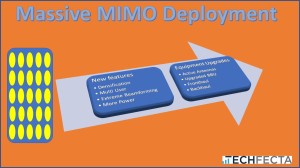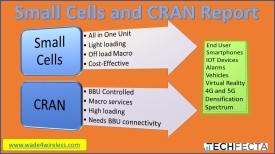Will 5G Transform RAN Design?
Will 5G Transform RAN Design?
I was reading a report from ABI Research, “5G WILL RADICALLY TRANSFORM RAN DESIGN AND TOPOLOGY AS MULTIPLE SPECTRUM BANDS AND USE CASES CONVERGE,” and I had to think about the radical changes we have already seen. However, they were not radical changes, were they? They were a slow evolution of sites. We saw small cells come to life only to become CRAN and cRAN. We have seen the network transform from T1s and DS3s to all Ethernet. Then we saw backhaul go from 1Mbps to 100Mbps to 1Gbps and now 100Gbps.
We have seen edge computing take off only to gradually become FOG computing to lower latency.
Let’s not forget that at one time Wi-Fi was a standalone technology and now licensed is looking for help from Wi-Fi to offload and trying to push unlicensed or lightly licensed LTE and 5G to support them. It’s becoming a ubiquitous network not matter what part of the network you are on.
We all say, “It’s the 5G revolution!”. If you’re in the industry, you know that’s all bullshit, right? We say that because it’s marketing and we love to brag about the latest and greatest technology that will save the world from destruction, or at least make us look cool in front of our peers when we have one of the first 5G devices, right?
It may be radical, but if you’re in the industry, you have seen this coming for a long time.
However, let’s look at the progression of the network over time.
Spectrum:
We need more spectrum. The FCC granted us more spectrum. What do we have today in the USA?
- All the original spectrum like 700MHz, 1.1GHz, 800MHz, 2.4GHz, and all the rest of the AWS, PCS and more.
- All the license-free spectrum, ISM bands,
- CBRS band,
- New 600MHz we got from broadcast,
- The new mmwave like 24GHz, 28GHz, and 39GHz,
- The really high stuff like 60GHz and 70GHz.
It’s really starting to add up. More spectrum for more services to serve more people in more ways.
Backhaul:
We really need to improve the backhaul. That’s why we use fiber everywhere. Where we can get fiber, we use wireless, but only if we can’t get fiber. It’s all ethernet now. It’s all using faster and better router to lower latency and to have SDN. It has to be smarter than ever because humans could not keep up. We now use a type of AI to define our networks. They have algorithms that make the networks smarter and faster. We need that.
Fog and Edge computing:
We need to have the servers closer to the end user so that they can lower latency for new applications. I don’t mean just apps, but for the cloud to be more responsive so that Artificial Intelligence and Augmented Intelligence will work better than ever before. It has to be better to that entertainment will see real value in it.

Why entertainment? Because that will lower the cost if larger entertainment dollars are spent on that new experience so that gamers can invest in it to lower costs even more and then, eventually, businesses will use it to lower costs by replacing people to improve customer service.
Applications:
We need new applications to drive new technology and lower costs. We also need more and more revenue coming in to support growth. The old model of adding more users isn’t going to cut it anymore. We need business applications to drive more business and make a new “need” out of these networks.
RAN
We need to discuss more than the RAN: We need to break down the small cells, CRAN, cRAN, macro sites, indoor coverage, licensed and license-free models. Of course, when we say RAN today, it means so much more than just cell sites, doesn’t it? It means the Het Net, densification, backhaul, routing, edge servers, offloading, and more.
The RAN starts at the macro site; they are still the key component. Sprint is making massive MIMO a priority. This goes beyond MIMO as we know it and creates a new era for active antennas. The massive MIMO antennas will be able to increase densification more than ever. This is what Sprint is banking on, having their 2.5GHz spectrum become the go-to spectrum for mobile and fixed. They have plenty of spectrum to use it for 4G and 5G. they have enough spectrum to make mobility or FWA work. They have a key asset there. One that they should have utilized long before 2019. I’m just saying that to sit on this asset is very sad. If they can roll this out, they should have mobility and FWA all wrapped up in one system. This is an evolution that is making inroads to the industry. They are on the bleeding edge of technology.
Another RAN upgrade is that they are deploying 5G radio heads. This will allow more efficiency over the air. LTE has been doing this, but now 5G should open up new doors.
What about the small cells? We don’t hear as much about them in the outdoor play because CRAN and cRAN are taking over. They are making a difference. This is the part of densification that needs to happen to make a real difference in 5G. I am not talking about just coverage here; I am talking about offloading, throughput, and low latency. If you work in RF or Fiber, then you know that distance matters. One of the key components of 5G performance is low latency to run all those fancy apps that we are looking forward to using.
Densification is more than coverage. However, it comes at a cost. The carriers in the US made it quite clear they are not going to foot the bill for small indoor venues. Who can pick up the slack? That’s another article, isn’t it? In fact, I touch on it here, https://wade4wireless.com/2018/11/25/in-building-wireless-the-next-frontier-for-integrators/ if interested.

So, when looking at densification, it’s the macro sites, the outdoor mini macro, and the indoor small cell.
We also need the lightly licensed and the license-free spectrum. These will be built like small cells. They will help to fill the indoor coverage. It’s going to play a role in the RAN network, like it or not. The OEMs have already rolled out LAA and LWA to satisfy this need. The need to get all the spectrum and cells to work together. They need to be tied together in a way that benefits everybody if your goal is to have ubiquitous carrier coverage. If you want a private LTE system, then screw the others and make it an isolated network. Who wants an isolated network? Manufacturing, secure businesses, R&D labs, wireless AI labs or centers, and more. There is a need for private LTE without connecting to carrier coverage, don’t forget that.
It’s not about the network; it’s about being different!
OK, this is something I picked up from a Seth Godin quote that I remember, I had to Google it because I think I heard it in an audiobook, but this blog came up, https://qz.com/work/1461996/seth-godin-does-your-logo-matter/, so I will use that as a reference. Seth said, (notice I said that like we know each other, and he has no idea who or what I am), anyway, Seth said, quote” How do we know that brands like Verizon and AT&T are essentially worthless? Because if we switched someone from one to the other, they wouldn’t care.”Why do I quote this when most everyone reading this is making a living off of the carriers in some way or another? Because it’s true! Look at Sprint, their entire marketing campaign says coverage doesn’t matter, do go with the lowest cost provider, Sprint. Yet, T-Mobile was able to differentiate themselves through “no contracts” and Legere marketing himself as the advocate for the millennials and wireless and through video services.
It is about being the next big thing and loyalty. However, that loyalty is disappearing. Do you know years ago Sprint had great customer service? Right before they merged with Nextel, I was a loyal Sprint customer even though the coverage sucked. Then they merged with Nextel, and the customer service became a customer’s nightmare. They became angry and mean. Many of the carriers had this problem, but I not only left Sprint for this reason and went to Verizon, but I hated Sprint for about 2 years! I mean I told everyone how they screwed me over for two solid years! Then they figured out that keeping customers happy matters and got back on track.
Why do I say this, because T-Mobile figures this out before any of the carriers! Unfortunately, people have short memories, so what do they have to do next?
Someone has to be different! I don’t mean offering 5G; they are all doing that, so what, someone is first, again, short memories. What can they do to be different? Well, coverage is about the same, densification is about the same, throughput is about the same, what can it be? Can it be the app? Anyone with an iPhone can get almost anything. We can get YouTube, Netflix, Amazon Prime, almost anything on any service.
I don’t have the immediate answer, but I think it could be a few things, and the carriers have to be open-minded, unlike Verizon when they turned down the iPhone for the first time. It could be AI services, free music or movies, or it could be something we don’t know about yet. Unfortunately for many of you reading this, the average consumer could care less about the edge, FOG computing, CRAN, densification, or any of the things that we get excited about. Just ask anyone outside of the industry if SDN will redefine wireless. I would bet the answer will be “huh” or “what?” before you explain it to them. Even after the explanation, they probably won’t care as long as they have 3 bars on their smartphone. Honestly, why would they care, they want bells and whistles, that’s what they are willing to pay for. Honestly, do you see them caring about low latency or IOT? No, they want the services that these features will bring them like AI or a smart thermostat or awesome video of live sports











Post a Comment